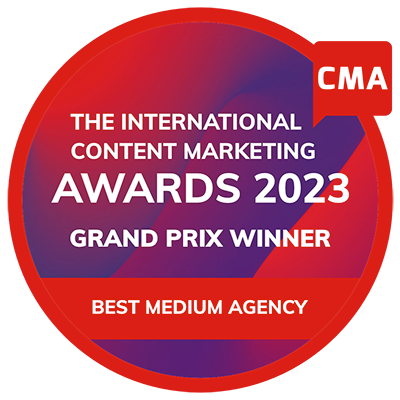
Is your web content fit for purpose?
Cathy Wood,
-
DOWNLOAD
Your Content Marketing Checklist >

-
REQUEST TODAY
A Content Consultation >

Your content marketing strategy demands well-crafted written content. Your website needs it, your social plan depends on it and your email campaigns are unlikely to succeed without it.
By ‘web content writing’, we’re referring specifically to the written copy that appears across digital platforms – not video, imagery or audio, but the words that shape a user’s understanding of your brand, offer value and drive action.
Whether you're writing for web pages, email sequences or social posts, each format requires different tactics. Tone, length, structure and language must be adapted to the channel and audience intent. An SEO blog post will have very different requirements from a LinkedIn carousel or a sales email.
All content should be planned and executed with your wider content strategy in mind. It needs to serve a clear purpose, support your messaging goals and perform across relevant platforms.
Video, VR and audio may be at the forefront of creative campaigns, but without high-quality written content to support them – optimised for each context – they risk underperforming. Whatever content you produce, make sure your words are fit for purpose.
The internet is awash with billions of pages of content, but only a tiny fraction of them are read, and an even smaller number are widely shared. Poorly executed copy fails to capture attention, fails to meet business needs and fails to deliver ROI.
Writing content for digital platforms – particularly content that is optimised for search engines – is not a dark art. With some thoughtful structure and a strategic approach, you can give your content a commercial edge in a saturated marketplace.
1) Make your web content valuable
Let’s start at the top: there must be a reason for your content to exist. That might sound basic, but even the most sophisticated digital campaigns can fail if content is created without a clear business goal or audience need in mind.
Effective content should serve a business objective and be audience focused. One framework we rate comes from Mark Coronna at Minneapolis-based Chief Outsiders, as published in Luxury Daily.
It offers a practical content checklist to assess commercial value:
- Intrusive: Will it get readers’ attention?
- Believable: Are the claims made both clear and reasonable?
- Credible: Does it contain facts and third-party endorsements or awards?
- Customer-centric: Does it stress benefits, applications or features?
- Memorable: Will readers be able to associate the offer with the brand or company?
- Actionable: Does the content inspire readers to take action?
This framework is a useful lens through which to plan and assess all written content – from website copy and social posts to thought leadership, email marketing and paid media.
In addition, consider how your content aligns with Google’s EEAT principles:
- Experience
- Expertise
- Authoritativeness
- Trustworthiness
These are key markers in assessing the quality and relevance of online content – not only for search engines, but for human readers too. If your content does not demonstrate EEAT, it is less likely to rank – and less likely to resonate.
Value can take many forms. It might inform, entertain, provoke or solve a problem. But it must give the reader something useful – or lead them somewhere worthwhile.
And to do that well, you need to know your audience. What do they care about? What do they search for? What hasn’t already been answered elsewhere? Content that fills a gap in knowledge, addresses a pain point or adds new insight is far more likely to deliver results.
2) Crafty keywords
The second of our 10 tips concerns keywords – a staple of SEO and still one of the most effective tools for discoverability when used intelligently.
Keywords and phrases should support your content, not dominate it. They should be integrated naturally, forming the structural spine of your copy, not padding. Prioritise using them in headings, subheadings, meta descriptions and alt text where appropriate, but avoid overuse. Both search engines and readers will penalise content that feels forced or stuffed.
Your keyword strategy should be directly informed by your content plan and your audience’s language. Think beyond your blog or landing pages – keywords should also inform social media captions, video titles, email subject lines and other copy-led formats.
To identify relevant and realistic keywords, go beyond the basics. Google Ads and Trends still have their place, but we recommend using more comprehensive SEO tools such as:
- SEMrush or Ahrefs for detailed keyword volume, competition and intent analysis
- AlsoAsked.com to explore real user questions and topic clusters
- AnswerThePublic for a visual map of commonly searched phrases
Remember, you’re aiming to match your audience’s search intent, not just their search terms. The right keyword, in the right context, used in the right way, can transform your content’s performance.
3) Super structure
Web readers are habitual scanners. With digital attention spans sitting below nine seconds, content needs to be easy to digest at speed.
That means well-structured copy is essential – both for the reader and for search engines. Start by breaking your content into clearly defined sections using a consistent heading hierarchy. Your H1 should be reserved for the title of the page, followed by H2s for key sections and H3s for sub-points.
Use bulleted lists, pull quotes, imagery and infographics to guide the eye and break up long blocks of text. These techniques not only aid readability but also support accessibility best practice and improve the user experience – particularly on mobile devices.
Structuring your content well also increases your chances of appearing in featured snippets or ‘zero-click’ search results. Consider how you can format key takeaways or answer-focused paragraphs to satisfy those search patterns.
If your content includes data, product listings or FAQs, you may also want to explore using schema markup to give search engines additional context and improve your visibility.
In short, make your structure work hard. It’s one of the easiest ways to make content more useful and more findable.
4) Hot headline
Headlines are still the make-or-break moment for most content. A compelling headline can dramatically increase clicks, shares and engagement – but only if it makes sense out of context.
Writing a clever headline or pun might appeal to existing users, but it won’t perform well in search or on external platforms. Instead, focus on clarity. Include a relevant keyword to help your content appear in search results and ensure the headline accurately reflects the content.
That doesn’t mean headlines should be dull. Injecting an action verb or emotional hook can help boost performance. Consider using ‘power’ words such as top, best, proven, or essential – but only if they’re accurate.
Your headlines should also be consistent across platforms. That means aligning your blog title with your email subject line and your social preview text. Consistency of message builds credibility and improves click-through.
If possible, test your headlines. A/B testing in email campaigns and previewing metadata in SEO tools can give you early indicators of what resonates.
Need a second opinion? Free tools like CoSchedule’s Headline Analyzer offer a useful way to benchmark your headline’s likely effectiveness.
5) Make your web content evergreen
Where possible, design content for longevity. Evergreen content – the kind that remains relevant and useful over time – tends to perform better in search, attract consistent traffic and offer stronger ROI.
To make your content evergreen, avoid including dates, trends or time-sensitive references unless necessary. Refrain from using phrases like ‘this year’ or pop culture references that will quickly date. Instead, focus on topics that your audience will continue to search for, regardless of the news cycle.
Evergreen content is also easier to repurpose. A well-written guide or thought leadership piece can be adapted into social content, email newsletters or internal comms over time, giving you greater mileage from each asset.
A smart content strategy includes both evergreen and timely material. When you do produce evergreen pieces, optimise them to be easily updated, re-shared and re-indexed.
6) Succinct sentences
We live in an attention economy and people don’t have time for long-winded, winding explanations. Give them the ‘meat’ quickly. Concise writing also contributes to perceived trustworthiness – a key element in Google’s EEAT framework. If your content is easy to understand, it’s more likely to be viewed as credible.
Here’s how:
- Clear, concise copy is essential for digital audiences. Short sentences make articles easier to scan, aid comprehension and improve user engagement –especially on mobile.
- To assess clarity and flow, run your copy through readability tools like Hemingway or Grammarly Business. These highlight overly complex structures, passive voice and jargon that could be simplified.
- Where appropriate, follow ‘plain English’ principles. This is especially important in public sector or regulated industries, where accessible communication is essential.
- Length still matters – but only if the value is sustained. A long article can perform well if it maintains relevance and interest. If it doesn’t, stop writing.
7) Punchy paragraphs
One-sentence paragraphs might look sparse in print, but on digital platforms, they’re a smart move. Short paragraphs improve scannability, help break up dense information and are far more user-friendly on mobile devices. They also allow you to emphasise key points and maintain a brisk reading rhythm.
8) Simple punctuation
Short sentences are aided by simple punctuation. It’s best to keep brackets, hyphens and semi-colons to a minimum as they rarely add to understanding.
9) Leading links
Links remain a crucial part of web writing – for both SEO and user value. A well-placed link can offer context, demonstrate authority or guide the reader to the next logical step.
Strike a balance between internal and external links. Internal links help users navigate your site and improve time on page. External links – to high-quality, credible sources – support your content’s authority and trustworthiness, reinforcing your EEAT signals.
Avoid dead links or broken redirects. These damage your SEO, erode trust and frustrate users. Regularly audit your content to ensure all links are still relevant and functioning.
Where possible, set links to open in a new tab so users don’t lose their place in your article.
10) Check, check and check your web content
This may seem like obvious advice, but it is worth reiterating: once written, check your work thoroughly or get someone to give it a tough critique. Spelling mistakes and grammatical errors can put readers off and make your article look sloppy.
Cut out any ‘fluffy’ sentences that don’t add value and check that it’s easy to read and understand. It’s also worth doing a quick count of your keywords to make sure you’ve made the best use of them.
HOWEVER, if you really, really need to get the content up ASAP, go ahead and post it. The great thing about a web page is that you can change it any time. Once it’s up, you can go through it and give it the proofing it deserves.
With the rise of generative AI, poor-quality content is often immediately recognisable. AI-generated copy can lack nuance, include hidden formatting errors or overuse generic phrasing. Tools like Originality.AI can help identify invisible characters, zero-width spaces and overly formal AI fingerprints.
Your content doesn’t have to be perfect on first publish – one of the benefits of web content is its editability. But brand reputation matters. Publish responsibly, then revisit with a critical eye and refine as needed.
11) Writing web content in the age of AI
The explosion of generative AI tools has fundamentally changed how content is produced. But as the barriers to content creation have lowered, the demand for quality, originality and human insight has only increased.
AI can be a valuable tool in your writing process – but only when used responsibly and strategically.
Start with a strong prompt
AI is only as good as the instructions you give it. Writing an effective prompt takes clarity, context and intent. If you want usable results, define your target audience, tone of voice, objective and format up front. Harvard offers a useful framework for crafting quality prompts here.
Use AI for acceleration, not automation
Treat AI as a collaborator, not a ghostwriter. Use it for ideation, outlining or gathering examples – but always apply human editorial judgement before publishing. Content written solely by AI often lacks specificity, nuance and tone – and is rarely aligned with your brand voice or goals.
Know what low-quality AI output looks like
There are several tell-tale signs:
- Overly formal or vague language
- Repetitive phrasing and generic claims
- Em dashes or inconsistent punctuation
- Lack of references or citations
- No clear point of view or originality
Many tools now exist to detect these issues. Originality.AI and GPTZero can help flag AI-written content, detect invisible characters (like zero-width spaces) and identify overly ‘synthetic’ phrasing.
Google’s stance on AI-generated content
Google has made it clear: content is judged on quality, not authorship. That means AI-written content is acceptable – but only if it demonstrates Experience, Expertise, Authoritativeness and Trustworthiness (EEAT). Generic, SEO-stuffed or misleading content will continue to be deprioritised.
To maintain quality at scale, it’s worth implementing internal guidelines for:
- Prompt engineering
- Human review workflows
- Tone of voice calibration
- AI attribution and transparency (where relevant)
AI can make content production faster – but it’s your editorial oversight that makes it effective.
AI is also great for research too, perplexity.ai offers readers sources of where it’s scraped its info from. Chat GPT also offers this functionality now too.
12) Measure what matters: success metrics for modern content
Once your content is live, performance tracking is essential. Metrics don’t just prove value – they also guide optimisation, distribution and editorial decisions.
Content success is measured across multiple platforms and touchpoints. Here’s what to focus on:
On your website
- Use GA4 (Google Analytics 4) to track engagement through event-based data: scroll depth, time on page, clicks and conversions
- Review user engagement time and return visits to understand content stickiness
- Monitor page load speed and mobile responsiveness – both influence SEO and user experience
In Search Console
- Monitor impressions, click-through rates and ranking changes
- Use the index coverage report to spot crawlability issues
- Implement structured data (schema markup) to improve eligibility for featured snippets and rich results
In email and social
- Track open rates, click-throughs and unsubscribes for email content
- Measure reach, engagement and shareability across social platforms
- Use UTM parameters to assess the true impact of external channels on web performance
Where possible, benchmark performance across content types and formats. Which formats are driving the most qualified traffic? Which headlines convert? Which distribution channels deliver ROI?
Measuring success in this way ensures your content stays relevant, strategic and accountable to the wider business goals.
Final thought: your content deserves better than average
In a landscape flooded with generic content and AI-generated sameness, the brands that win are those that combine clarity, originality and purpose. Whether you’re briefing an agency, leading an in-house team or refining your tone of voice, the principles of great content writing remain the same: be useful, be strategic and be intentional.
Strong digital copy doesn’t happen by accident. It’s shaped by insight, guided by goals and sharpened through iteration. From SEO structure and platform alignment to human-led editing and smart AI use, the bar for what counts as ‘fit for purpose’ has never been higher.
If your content isn’t helping people find you, trust you or act on your offer – it’s not working hard enough.
Now’s the time to raise your standard. Because good content isn’t just found. It’s felt. And it’s remembered.
Don't leave your web content up to chance – or worse still, leave it to machines. Contact us to find out how you can make your web content more effective.
Resources
SEO Tool for analysis – SEM Rush
SEO Tool for keyword research – Ahrefs
Real user questions and topic clusters – AlsoAsked.com
Commonly searched phrases – AnswerThePublic
Headline Analyzer – CoSchedule
Make your writing concise and correct – Hemingway
Copy readability tool – Grammarly Business
Fix AI generated copy – Originality.AI
Craft effective AI prompts – Harvard
Detect issue with AI copy – GPTZero
AI Research with sources linked – Perplexity.ai
Related articles
Read more insightful articles
See more from the blogThe future of luxury hospitality – Part 3: Wellness and the quest for meaning
The future of luxury hospitality – Part 2: Purpose and sustainability
The future of luxury hospitality – Part 1: Personalisation and technology
Behind the lens at the European H.O.G. Rally: how brand immersion drives creative agility
Proud to be a winner of industry awards, recognised as content marketing experts in print and digital media.












